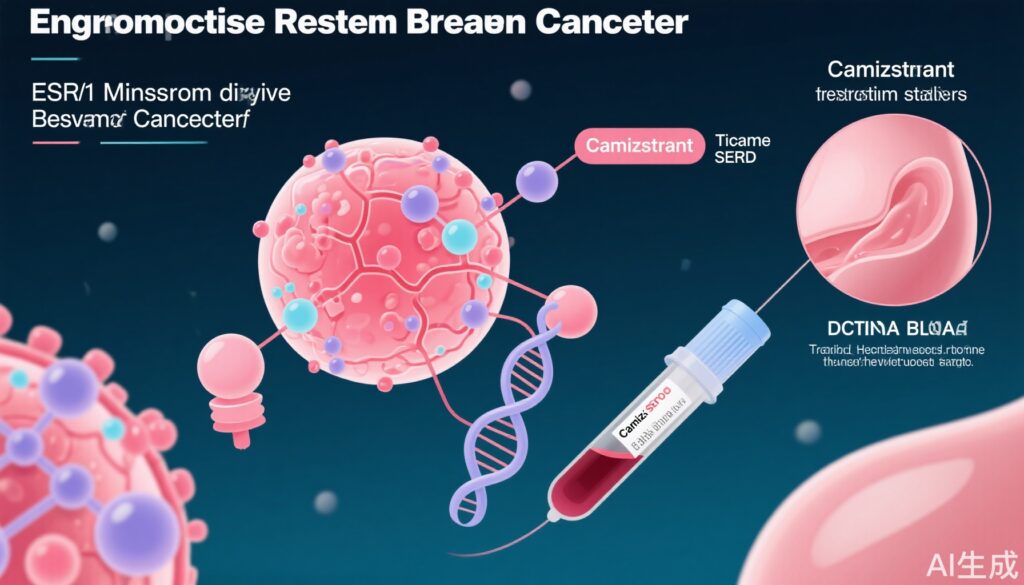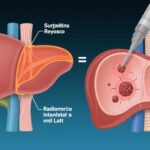Highlights
- Switching to camizestrant plus CDK4/6 inhibitor in patients with emerging ESR1 mutations significantly extends progression-free survival compared to continued aromatase inhibitor therapy.
- Camizestrant demonstrates superior efficacy over fulvestrant in previously treated, ER-positive, HER2-negative advanced breast cancer patients.
- Patient-reported global health status and quality of life were maintained longer with camizestrant than with standard therapies.
- Safety profile for camizestrant is acceptable and comparable to standard endocrine therapies, with a low rate of treatment discontinuation due to adverse events.
Study Background and Disease Burden
Estrogen receptor-positive (ER+), HER2-negative advanced breast cancer constitutes the majority of hormone-driven breast cancers. While the combination of aromatase inhibitors (AIs) and CDK4/6 inhibitors is now standard first-line therapy, acquired resistance remains a critical challenge. Mutations in ESR1, the gene encoding estrogen receptor alpha, represent the most prevalent mechanism of resistance, particularly following AI exposure. These mutations enable tumor cells to activate estrogen receptor signaling independent of circulating estrogen, rendering AIs ineffective. The clinical need for effective interventions targeting ESR1-mutated, AI-resistant disease is urgent, given the poor prognosis associated with endocrine resistance.
Camizestrant is an oral, next-generation selective estrogen receptor degrader (SERD) and complete ER antagonist. Unlike fulvestrant, which requires intramuscular injection and has limited ER degradation capacity, camizestrant offers potent, oral, and complete antagonism of ER signaling. Its clinical impact in overcoming ESR1-mutant resistance is now being elucidated in pivotal trials.
Study Design
SERENA-6 (NEJM, 2025): This phase 3, randomized, double-blind trial enrolled patients with ER+, HER2– advanced breast cancer who had received at least 6 months of first-line therapy with an AI plus a CDK4/6 inhibitor (palbociclib, ribociclib, or abemaciclib). Patients were serially tested for ESR1 mutations via ctDNA every 2–3 months. Upon detection of an emerging ESR1 mutation without radiological progression, patients were randomized (1:1) to either:
- Switch to camizestrant (75 mg daily) plus continued CDK4/6 inhibitor, with placebo replacing the AI.
- Continue AI plus CDK4/6 inhibitor, with placebo replacing camizestrant.
The primary endpoint was investigator-assessed progression-free survival (PFS). Secondary endpoints included time to deterioration in patient-reported global health status/quality of life and safety.
SERENA-2 (Lancet Oncol, 2024): This open-label, multicenter, phase 2 trial randomized postmenopausal women with ER+, HER2– advanced breast cancer (progressed on ≤1 line of endocrine therapy) to camizestrant (75, 150, or 300 mg orally daily) or fulvestrant (500 mg IM). Stratification was by prior CDK4/6 inhibitor use and site of metastases. The primary endpoint was investigator-assessed PFS; safety and tolerability were secondary endpoints.
Key Findings
SERENA-6 Results:
– Among 3,256 patients screened, 315 with emergent ESR1 mutations and no radiological progression were randomized (camizestrant: n=157; AI: n=158).
– Median follow-up: 12.6 months.
– Median PFS was 16.0 months (95% CI: 12.7–18.2) for camizestrant versus 9.2 months (95% CI: 7.2–9.5) for continued AI (hazard ratio [HR] for progression or death: 0.44; 95% CI: 0.31–0.60; P<0.0001).
– Deterioration in patient-reported global health status/quality of life occurred at a median of 21.0 months with camizestrant vs 6.4 months with AI (HR: 0.54; 95% CI: 0.34–0.84).
– Discontinuation due to adverse events: 1.3% (camizestrant) vs 1.9% (AI).
SERENA-2 Results:
– 240 patients were randomized (camizestrant 75mg, n=74; 150mg, n=73; 300mg, n=20; fulvestrant, n=73).
– Median follow-up: ~16 months (across groups).
– Median PFS: 7.2 months (90% CI: 3.7–10.9) for camizestrant 75mg, 7.7 months (5.5–12.9) for camizestrant 150mg, vs 3.7 months (2.0–6.0) for fulvestrant.
– HR for progression or death: 0.59 (camizestrant 75mg vs fulvestrant; 90% CI: 0.42–0.82; p=0.017); 0.64 (150mg vs fulvestrant; 90% CI: 0.46–0.89; p=0.0090).
– Treatment-related adverse events (grade ≥3) were rare (<3% in any group); no treatment-related deaths.
– Camizestrant demonstrated a higher rate of low-grade, manageable adverse events (e.g., gastrointestinal, hepatic), but overall safety was comparable to fulvestrant.
Comparative Summary Table:
| Study | Population | Intervention | Comparator | Median PFS (months) | HR (95% CI) |
|---|---|---|---|---|---|
| SERENA-6 | ER+ HER2–, ESR1-mutant, post-AI+CDK4/6 | Camizestrant + CDK4/6i | AI + CDK4/6i | 16.0 vs 9.2 | 0.44 (0.31–0.60) |
| SERENA-2 | ER+ HER2–, post-endocrine progress | Camizestrant 75/150mg | Fulvestrant | 7.2/7.7 vs 3.7 | 0.59/0.64 |
Expert Commentary
The SERENA-6 and SERENA-2 trials represent a paradigm shift in the management of endocrine-resistant, ER+ advanced breast cancer. The use of longitudinal ctDNA surveillance to identify emerging ESR1 mutations enables a precision medicine approach, intervening before radiological progression. Camizestrant offers a robust, oral, and well-tolerated solution, outperforming both AIs and fulvestrant in progression-free survival.
Guidelines have increasingly recognized the importance of targeting ESR1 mutations, and camizestrant may soon become a preferred option in this setting. Notably, the safety profile supports its use, with minimal discontinuation rates and no unexpected toxicities. However, some questions remain, including its efficacy in ESR1-wildtype populations and the optimal sequencing with other endocrine or targeted therapies.
Conclusion
Camizestrant, as demonstrated in SERENA-6 and SERENA-2, provides a clinically meaningful benefit for patients with advanced ER+, HER2– breast cancer harboring ESR1 mutations. By significantly extending progression-free survival and maintaining quality of life with a favorable safety profile, camizestrant is poised to redefine first-line management of endocrine-resistant disease. Ongoing studies will clarify its broader role, but current data support its integration into clinical practice for this high-risk population.
References
1. Bidard FC, Mayer EL, Park YH, et al.; SERENA-6 Study Group. First-Line Camizestrant for Emerging ESR1-Mutated Advanced Breast Cancer. N Engl J Med. 2025;393(6):569-580. doi: 10.1056/NEJMoa2502929.
2. Oliveira M, Pominchuk D, Nowecki Z, et al. Camizestrant, a next-generation oral SERD, versus fulvestrant in post-menopausal women with oestrogen receptor-positive, HER2-negative advanced breast cancer (SERENA-2): a multi-dose, open-label, randomised, phase 2 trial. Lancet Oncol. 2024;25(11):1424-1439. doi: 10.1016/S1470-2045(24)00387-5.


